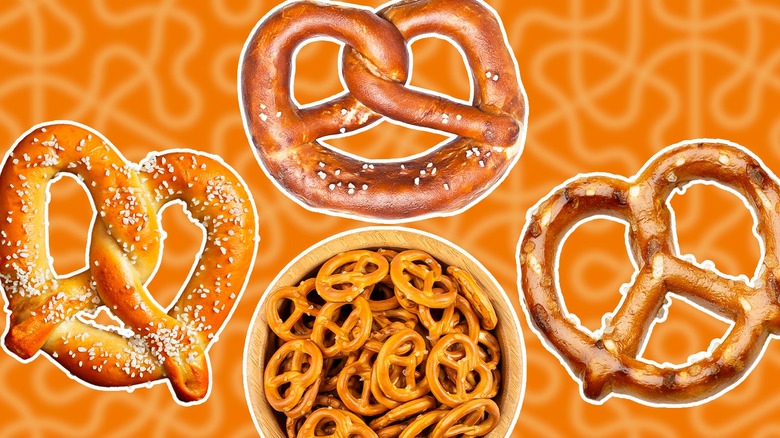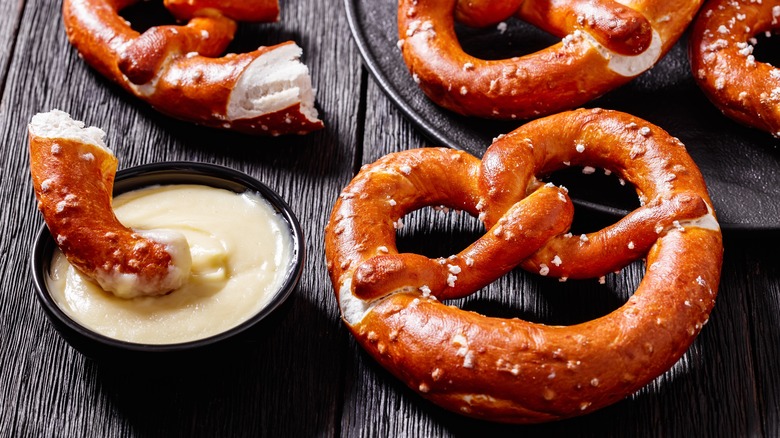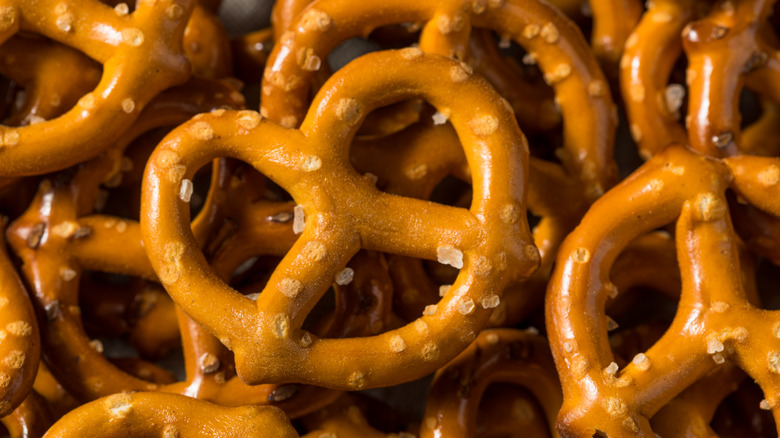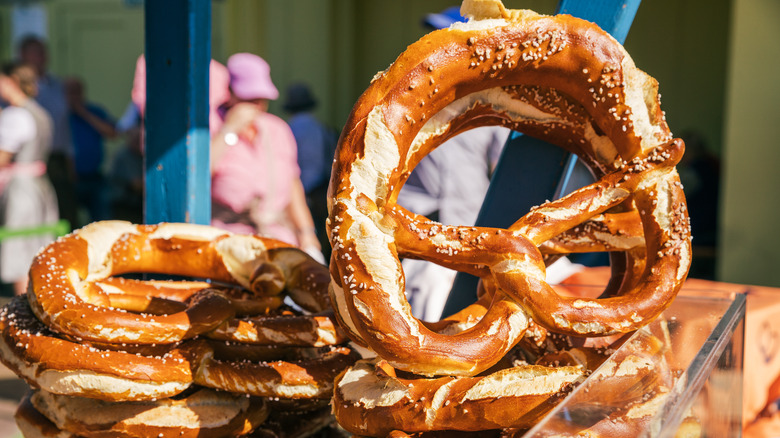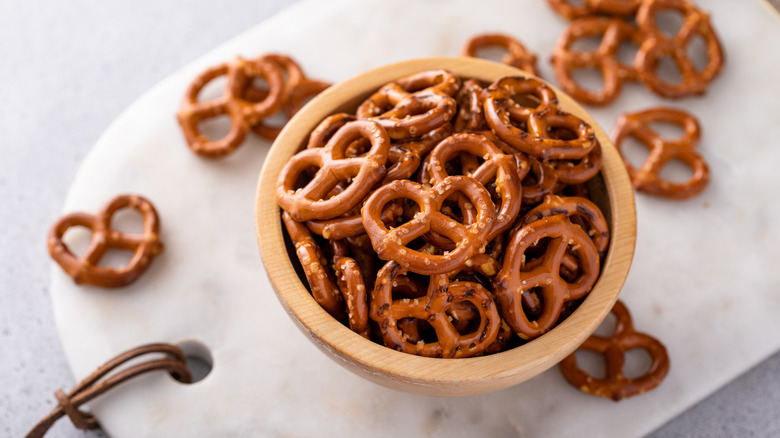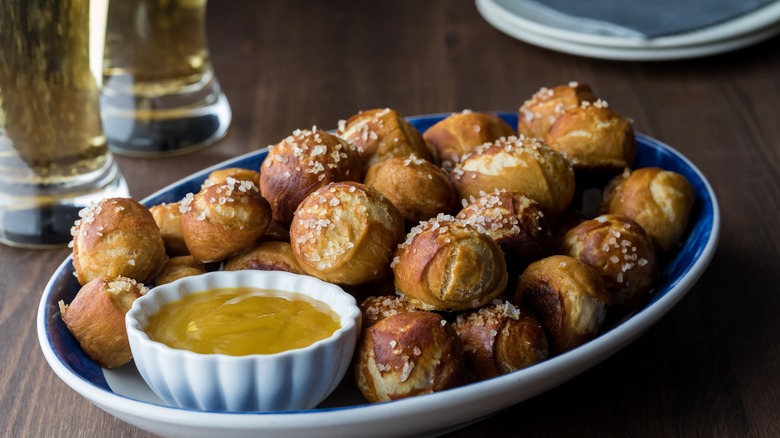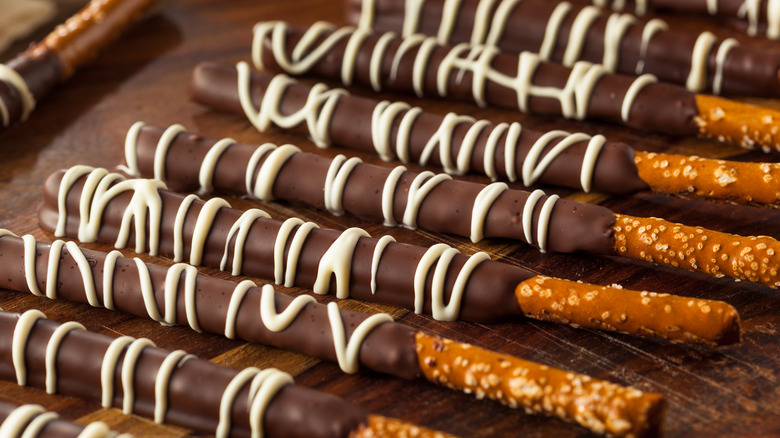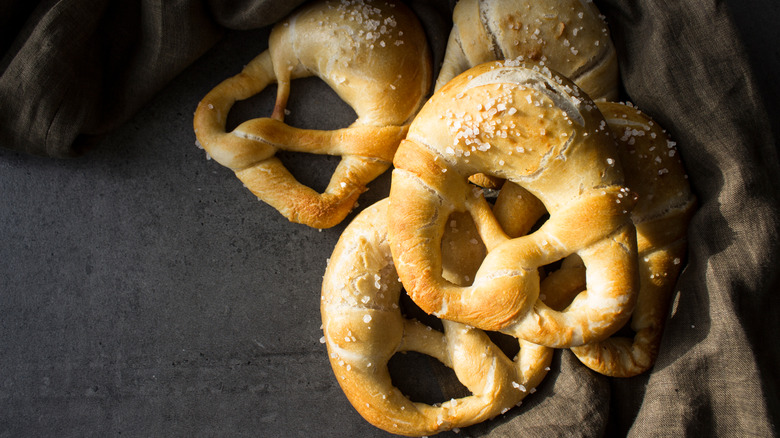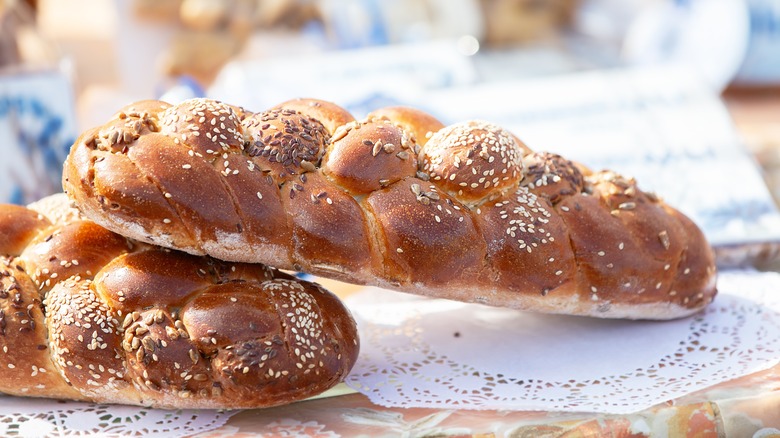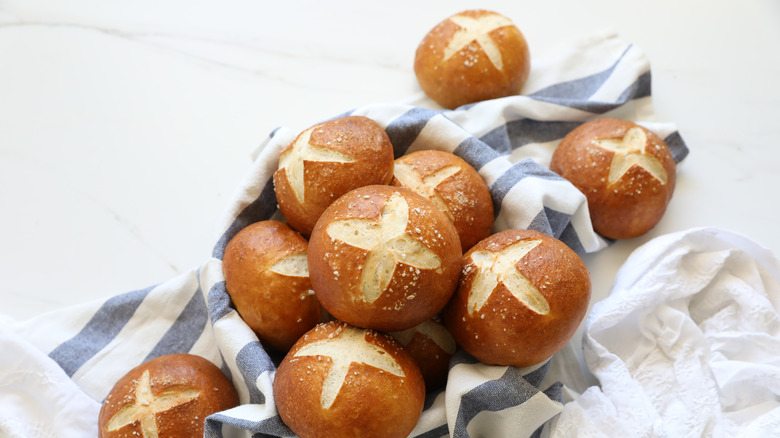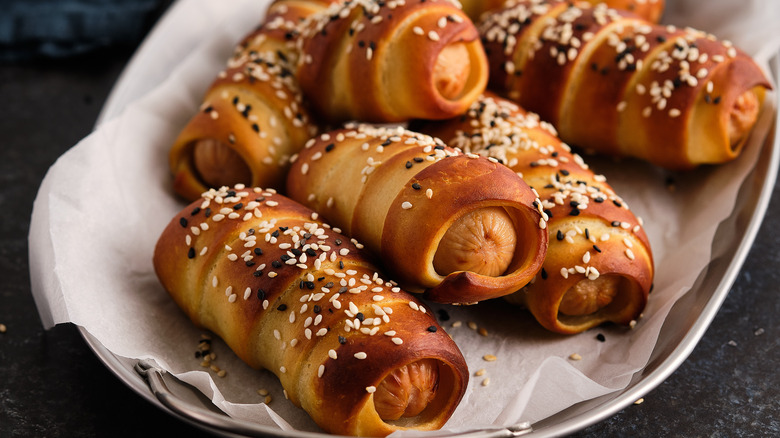11 Types Of Pretzels, Explained
Pretzels are a beloved snack dating back many hundreds of years. Since their creation in the seventh century, pretzels have taken on many shapes, flavors, and textures. Still, despite these different forms, there are only two main types of the doughy treat: soft and hard pretzels.
Soft pretzels are warm and chewy with a golden-baked exterior, while hard pretzels are drier and more brittle, offering a satisfying crunch when biting into them. Hard pretzels also have a longer shelf-life and are more versatile than their softer counterpart, which has led to many variations of the iconic treat.
Over the years, pretzels have evolved past their original shape, expanding to everything from nuggets and sticks to buns and rolls. Today's pretzel makers have also widened their ingredients lists and tried different approaches, such as using sourdough instead of regular pretzel dough. With all that in mind, here are the different types of pretzels explained.
Soft pretzels
Invented in 610 A.D. by European monks, soft pretzels are the original form of the treat. Consisting of water, flour, and salt, the Catholic Church took a liking to the pretzel early on because they considered it the "ideal food" to eat during Lent, which restricted meat, dairy, and eggs from the diet. During the Middle Ages, the soft pretzel spread across Europe, becoming a popular treat among medieval peasants who saw it as a symbol of good luck and prosperity. Germany in particular embraced the new twisted treat, and soon various regions in the country would develop their own recipes. In the 1700s, German immigrants introduced the pretzel to the American population, and it soon became a staple in bakeries in cities such as Philadelphia.
Today, the soft pretzel is as popular as ever in America, selling at stadiums, amusement parks, shopping malls, and breweries. Soft pretzel recipes also haven't changed much since the early days — they still involve a mixture of water, flour, salt, and yeast. Soft pretzels are still the same warm, chewy treats of yesteryear, twisted in a symmetrical knot. What has changed is the amount of toppings one can add to their soft pretzel. Consumers can dress up their pretzels by adding everything from cinnamon sugar to pizza toppings. There is also an entire market of pretzel dipping sauces, encompassing a variety of flavors. While the soft pretzel was once a symbol of prosperity, it is now a timeless treat to be enjoyed by all.
Hard pretzels
Hard pretzels were invented by Julius Sturgis in Pennsylvania in 1850. As the story goes, after selling soft pretzels in his bakery, Sturgis had problems with his products growing stale quickly. The baker needed a solution that would allow him to keep fresh pretzels on hand for longer. His solution was a new form of pretzel with a hard, crunchy consistency. After years of development, Sturgis began selling the new treat in his bakery. The hard pretzels were so popular that Sturgis couldn't keep up with the demand. This led the baker to open the first commercial pretzel bakery in 1861, and the rest is history.
What makes hard pretzels different from soft pretzels is the lack of moisture. Since hard pretzels don't require as much water, they come out of the oven more brittle, making them less susceptible to becoming stale. Because of this, hard pretzels have a longer shelf life, which made them ideal for pretzel makers who didn't need to sell their products as quickly as they did with the softer variety.
Hard pretzels are a more versatile product, and, as such, an entire market has sprung up around them. According to statistics from the IMARC Group, the value of the global pretzel market is expected to reach $10.1 billion by 2032, and the hard pretzel accounts for the majority of the market share. When Sturgis developed his new type of pretzel, he unknowingly sowed the seeds for a multi-billion dollar business.
German or Bavarian-style pretzels
Germany has long been associated with pretzels, specifically in the southern region of Bavaria. Known as "bretzel" in German, the pretzel had become a symbol of baking culture in Germany by the 12th century. Over the next few hundred years, pretzels evolved to become a staple of German cuisine and were served for all types of occasions, including weddings, holidays, and more. They were also served at different parts of the day, such as at breakfast or for an afternoon snack. Although various regions in Germany developed their own pretzel recipes, the Bavarian-style pretzel became the best known type in other parts of the world.
Bavarian pretzels differ in several ways from American pretzels. Firstly, the Bavarian pretzel is more dense and chewy than its American counterpart, and it has a darker and crispier exterior. Secondly, Bavarian pretzels offer a tangier taste than other types of soft pretzels. Another thing that differentiates German and American pretzels is that the former utilizes the traditional "bath" of lye before cooking, which gives the treat its shiny appearance, whereas American pretzels tend to use a solution of baking soda and water. Lastly, Bavarian-style pretzels are often enjoyed at room temperature without the aid of any dipping sauce or butter topping.
Mini pretzel twists
Since the invention of the hard pretzel, aspiring pretzel makers across America and beyond have tried putting their own spin on the delicious treat. Hence the emergence of the mini pretzel twist (also known as the traditional or basic twist). Over the years, companies have developed a snack-sized version of the hard pretzel that is just as crunchy and brittle as the original. Utilizing similar pretzel-making techniques, such as using less water, these twisted snacks last longer on the shelf, allowing companies to experiment with different recipes without worrying too much about waste.
Popular pretzel brands, such as Utz, Rold Gold, and Snyder's, offer products ranging from lightly salted to honey mustard. You can also find these types of pretzels dipped in chocolate for a delicious dessert. Among the many types of pretzels on the market, the traditional twist is one of the most popular, which becomes evident when you're browsing the snack section of any supermarket. When you see just how many options there are these days, it becomes clear how far the hard pretzel has come since its early days in Julius Sturgis' bakery.
Pretzel nuggets or bites
If you fancy trying a pretzel with a non-traditional shape, pretzel nuggets are a delicious option. Sometimes called pretzel bites, these small versions of the twisted treat are easy to eat and great for dipping. The best part is that you can find both soft and hard pretzel nuggets in stores and restaurants. Both types of nuggets are essentially made using the same dough as regular pretzels, they're just cut up into smaller chunks. From there, the nuggets are boiled in a baking soda and water solution and baked until golden brown. Many recipes call for sprinkling salt over the nuggets, but you can also customize them in any way you see fit.
In many cases, hard pretzel nuggets are stuffed with some kind of filling, such as peanut butter, cheese, or chocolate. You can also find them coated in seasoning or flavoring, including pizza or buffalo sauce. Soft pretzel nuggets, like those sold at popular pretzel stands such as Auntie Anne's or Wetzel's Pretzels, are often topped with butter, pepperoni, cinnamon sugar, and more. These types of pretzel nuggets are also great for dipping in your favorite cheese sauce.
Pretzel sticks or rods
Pretzel sticks or rods are another type of hard pretzel that forego the traditional pretzel shape. Often resembling toothpicks, pretzel sticks are long and thin and provide the same amount of crunch as a traditional pretzel twist. Pretzel rods are another variation of the stick variety, and are typically longer, thicker, and offer an even greater crunch. For the most part, many of the same brands that sell traditional pretzel twists also sell some form of pretzel stick or rod.
Both pretzel sticks and rods are excellent snacks for on-the-go eating since they fit nicely in pockets or cup holders. You can also serve them alongside various dips and sauces as a delicious appetizer. While you can find many options simply coated in salt, gourmet pretzel makers also dip the sticks or rods in chocolate for a sweet and savory treat. Making chocolate-covered pretzel sticks at home is incredibly easy (and, pro tip, if you want to make them without a flat side, simply punch some holes in a cereal box and stand them up). You can also jazz-up your chocolate pretzel sticks by sprinkling on various toppings while the chocolate is still wet.
Pretzel Crisps
Pretzel Crisps are relatively new in the world of pretzels. After working in a pretzel factory, inventors Sara and Warren Wilson got the idea to remove the air from the treat. This new deflated pretzel would take years to perfect, and there was also a legal trademark battle that they had to navigate, with Frito-Lay (who make Rold Gold pretzels) objecting to the name being trademarked. In the end, a federal judge ruled that "pretzel crisps" is a generic term that cannot be trademarked, but that hasn't stopped Pretzel Crisps (which entered the market under the Snack Factory label) from being a big hit.
As the name implies, Pretzel Crisps resemble chips. While they still retain the original pretzel shape, they are very thin and almost completely flat. Because they are a hard pretzel at heart, the crisps still supply a satisfying crunch. Pretzel Crisps are available in various flavors, including garlic parmesan, cheddar cheese, and buffalo wing. You can also get them covered or drizzled in chocolate for a mouthwatering treat. The brand also recently released Pretzel Crisps Bites, which are smaller versions of the original product.
By all accounts, Pretzel Crisps has been an outright success. Demand for the product has been high. According to data published by Statista, 2.34 million Americans consumed at least four bags of Pretzel Crisps in 2020 alone, and sales are only improving, with the brand now worth an estimated $120 million. Pretzel Crisps are one of the most innovative takes on the classic pretzel since Julius Sturgis' invention of the hard pretzel in 1850.
Sourdough pretzels
It isn't just shape that differentiates the various types of pretzels — ingredients can make that determination, as well. Such is the case with sourdough pretzels. Sourdough bread has a lengthy history dating back thousands of years. Long before the availability of commercial yeast, bread makers made leavened bread by utilizing dough fermented by lactic acid bacteria and wild yeast, which is a practice still utilized today. In recent years, sourdough bread has seen a massive resurgence with a market estimated to surpass $6.47 billion by 2033, according to data from The Brainy Insights. Trying to capitalize on this popularity, many pretzel makers have turned to swapping out normal pretzel dough for sourdough instead.
There are a few key differences between sourdough pretzels and regular pretzels. For one thing, sourdough pretzels require a sourdough starter – which is simply flour and water left to ferment – as opposed to using yeast. What this creates is a lighter texture that provides a better crunch than traditional pretzels. Additionally, sourdough pretzels have a much richer and tangier taste, a common characteristic of sourdough bread. Due to these reasons, sourdough pretzels are a delicious alternative that can be shaped into any type of pretzel, including twists, sticks, and nuggets. If you're curious about them, then why not try our soft sourdough pretzel recipe.
Braided pretzel bread (pretzel challah)
Braided pretzel bread is essentially challah bread with a pretzel overlay. Challah is a type of bread in the Jewish religion that is served on certain celebrations, including Shabbat and other holidays. "Challah is the centerpiece ceremonial bread for Ashkenazi Jews — those of us who draw their cultural origins spanning from Eastern Europe to Germany or thereabouts, whose ancestors spoke Yiddish alongside whatever language needed to survive in their home country," Chicago baker Rachel Mennies wrote in a Wordloaf guest post. "Challah is usually made before sundown on Shabbat to commemorate the holiday's start and is blessed before dinner."
Challah recipes vary from place to place and person to person (some call for a single egg, for example, while others will use over a dozen). However, no matter how you make it, the process for turning your challah into a pretzel challah is more or less the same. Similarly to how soft pretzels are made, you will need to boil the dough in a baking soda and water solution to achieve that perfect pretzel crust. If you're not feeling up to making your own, fear not — many bakeries are now selling braided pretzel bread and you can even buy them online to enjoy at breakfast time.
Pretzel rolls or buns
Pretzel rolls and buns are game changers when it comes to sandwiches, and, as such, they have exploded in popularity in recent years. You can substitute them for regular rolls or buns in everything from ham and cheese sliders to chili hot dogs. They provide an extra boost of flavor and complement the ingredients within the sandwich, especially when using a mustard spread. Plus, since pretzel buns are typically denser than regular ones, they are much heartier and more filling. You can also forego the sandwich entirely and eat the rolls by themselves with a dash of butter or mustard for a truly excellent appetizer.
Many restaurants and grocery stores now offer pretzel buns or rolls. For restaurants, pretzel buns help differentiate their sandwiches from competitors. For grocery stores, pretzel buns allow consumers to elevate their meals at home. You can also opt to make your own pretzel buns or rolls from scratch. Similarly to braided pretzel bread, pretzel buns and rolls are made the same way as regular ones: You just have to boil the dough in baking soda and water to get that pretzel crust. We recommend sprinkling your buns or rolls with coarse sea salt when they're still warm for added flavor. Poppy seeds and sesame seeds are also good options.
Pretzel dogs
Pretzels and hot dogs have a lot in common. For one thing, they are both one of America's favorite dishes, selling everywhere from stadiums to shopping malls. Additionally, just like pretzels, hot dogs and sausages have deep roots in Germany — immigrants brought them to America, where they became staples. Because of these similarities, it only makes sense that combining pretzels and hot dogs would be a match made in heaven. They are basically the pretzel version of pigs in a blanket (what's not to love about that?) and are a common dish served at cocktail parties and family gatherings.
A pretzel dog is basically chewy pretzel dough wrapped around a hot dog or sausage, which is baked until golden brown. The pretzel crust offers a satisfying crunch that pairs perfectly with the soft, warm hot dog tucked inside. You can also customize your pretzel dogs for added flavor, such as stuffing them with cheese. We recommend serving your pretzel dogs with a side of honey mustard to further complement the crust. No matter how you prepare or serve your pretzel dogs, they are guaranteed to be a crowd-pleasing favorite and they always make for a great snack.
